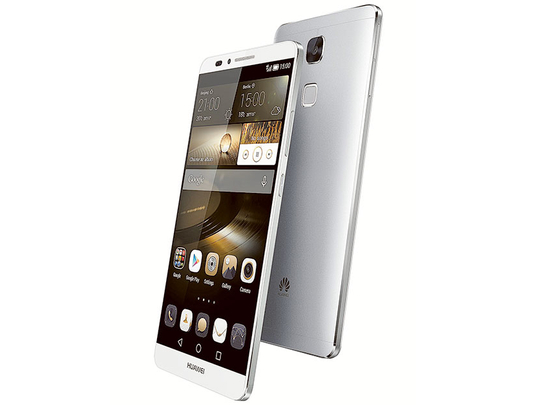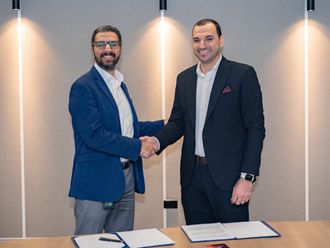
Dubai:
Huawei’s latest flagship phablet — Ascend Mate 7 — is a successor to last year’s Ascend Mate 2 albeit smaller in size.
Ascend Mate 2 had a 6.1-inch display, while Mate 7 measures six inches and boasts of an aluminium unibody with rear-mounted fingerprint scanner to catch the headlines.
Huawei is focusing on the design aspect for its premium phones and the new-look Emotion user interface 3.0 is intuitive.
The device is powered by in-house Hisilicon Kirin 925 processor made up of a quad-core 1.8GHz Cortex A15 chip and a quad-core 1.3GHz Cortex A7. It comes with 2GB RAM and 16GB internal storage capacity. Out of the 16GB, only 11.28GB is available for users. Huawei also offers 5GB of Huawei cloud storage facility apart from Google and others.
The micros SD card slot supports up to 32GB additional storage capacity and runs on Android KitKat version.
The Full HD IPS LCD screen (1920 x 1080 resolution) has only 368 pixels per inch which puts it below average when compared to other-high end devices. Although it offers bright and vibrant colours, the whites are not quite as crisp and natural as the black, with a slight tint even on cool mode.
Huawei should have opted for the 2560 x 1600 pixel resolution to stay with the crowd.
The device is big and the size prohibits single-handed operation, however Huawei has done what it can to make it easier. There is an option that lets the user tilt the device so that the keys turn to either right or left side for index finger or thumb operations depending on the user’s preference.
Moreover, Huawei has minimised the bezel to give more screen area with an 83 per cent screen-to-body ratio. The side bezels are only 2.9mm with 7.9mm thick with slight curvature on the back edges. It weighs only 185 grams.
The back of the device, just below the camera houses the fingerprint scanner. It is simple and fast, just place your finger on the scanner and that’s it. The scanner can be used to awaken the phone instantly without using the power on switch and it work very well.
It stores up to five different fingerprints and users will be asked to press their finger at different angles to capture the imprints. The data from the fingerprint scanner is encrypted on the device and certain apps can be opened with the fingerprint.
Huawei had added some intuitive apps, apart from the bloatware, such as performance manager app that lets users optimise performance manually or automatically, which I found to be very useful. It tells how much memory other apps are consuming and lets you terminate it.
Pedometer app shows the number of steps taken.
The notification panel is presented as a timeline; it gives the time of the item sent to you and the action done by the user.
The full HD screen consumes more battery power, but Huawei has added three power saving modes — normal smart and ultra — to extend the battery life. A quick scan will automatically let the phone sort out the issue and add some more minutes to the battery.
The 13MP rear camera with flash has few cool features. The ISO ranges from 100-800 and the exposure, saturation, contrast and brightness can be adjusted manually. The voice and fingerprint-activated shooting is simple and fast and works well. It has options to geo-tag pictures and face detection.
It works very well in lowlight conditions. It produces good colours, an even exposure and plenty of details at full screen.
Huawei has kept the modes fairly simple too. There aren’t too many crazy processing filters like on other smartphone but Huawei has stuck to Panorama, Beauty mode, HDR, burst mode and Watermark. The HDR (high dynamic range) did a fair job of balancing out shadows and highlights.
Overall the results are decent, even if Mate 7 can’t take the crown for the best results.
The 5MP front-facing camera provides 720p video. With good light conditions it produces a good selfie with 22mmwide angle mode.
Games such as Dead Trigger 2, N.O.V.A 3, Need for Speed and Asphalt 8 played smoothly with no lags and the real benefit is the huge screen.
The massive non-removable 4,100mAh battery is the biggest on a smartphone and it gives 17 hours of video playback while Galaxy S5 gave 15 hours. It clocked more than 12 hours of use in heavy drain test. For normal users, it will give close to two days of use which is pretty good.
Regarding connectivity, it has NFC, WiFi, Bluetooth 4.0 and Cat 6 LTE support download speeds of up to 300 Mbps.
It is priced at Dh1,899











